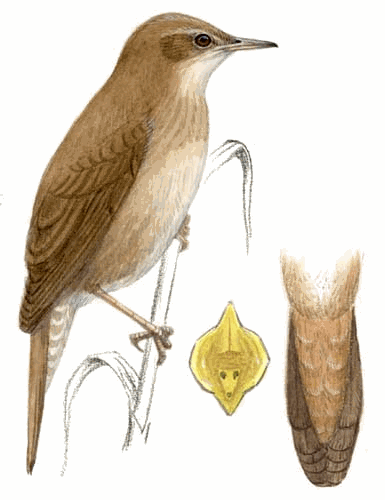
Savis Warbler
[order] PASSERIFORMES | [family] Locustellidae | [latin] Locustella luscinioides | [UK] Savis Warbler | [FR] Locustelle luscinioide | [DE] Rohrschwirl | [ES] Buscarla Unicolor | [NL] Snor
Subspecies
| Genus | Species | subspecies | Breeding Range | Breeding Range 2 | Non Breeding Range |
| Locustella | luscinioides | EU | c, w, sw, also nw Africa | AF | |
| Locustella | luscinioides | fusca | |||
| Locustella | luscinioides | luscinioides | |||
| Locustella | luscinioides | sarmatica |
Physical charateristics
Small to medium sized warbler, not as shy as smaller Locustella and with uniform brown plumage strongly suggesting some Acrocephalus warblers.
Sexse similar, no seasonal variation.
Sexse similar, no seasonal variation.
Listen to the sound of Savis Warbler
[audio:http://www.aviflevoland.nl/sounddb/S/Savis Warbler.mp3]
Copyright remark: Most sounds derived from xeno-canto
| wingspan min.: | 18 | cm | wingspan max.: | 21 | cm |
| size min.: | 13 | cm | size max.: | 15 | cm |
| incubation min.: | 11 | days | incubation max.: | 15 | days |
| fledging min.: | 11 | days | fledging max.: | 15 | days |
| broods: | 2 | eggs min.: | 3 | ||
| eggs max.: | 6 |
Range
Eurasia : Central, West, Southwest, also Northwest Africa
Habitat
Breeds in west Palearctic lowlands across middle and lower middle latitudes, in ample and unbroken cover of swamps, wetlands, floodlands, and inundated fringes of fresh or brackish surface waters, including sometimes fairly deep lakes and rivers, nest-site being usually approachable only by wading. List of suitable vegetation as follows: more or less extensive stands of reed, reedmace, fen sedge, bur-reed, sedge, or club-rush, often flanked by willows, alder, and other moisture-loving trees and shrubs.
Reproduction
Breeds May-July in West and Central Europe, mid April in South Europe. Nest site i built in tall, aquatic or semi-aquatic vegetation over swampy ground or water. Nest, well concealed cup with outer layers loosely constructed of dead water-plant leaves and inner section often more tightly woven from grass stems. Iner cup of finer leaves and fibres.
3-4 eggs are laid, incubation 10-12 days, by both sexes.
3-4 eggs are laid, incubation 10-12 days, by both sexes.
Feeding habits
Mainly adult and larval arthropods, also snails. Feeds mainly low in dense vegetation, taking food also from water surface and from ground. When feeding on ground either walks relatively slowly and deliberated or hops, picking items from ground and stems.
Conservation
This species has an extremely large range, and hence does not approach the thresholds for Vulnerable under the range size criterion (Extent of Occurrence <20,000 km2 combined with a declining or fluctuating range size, habitat extent/quality, or population size and a small number of locations or severe fragmentation). Despite the fact that the population trend appears to be decreasing, the decline is not believed to be sufficiently rapid to approach the thresholds for Vulnerable under the population trend criterion (>30% decline over ten years or three generations). The population size is extremely large, and hence does not approach the thresholds for Vulnerable under the population size criterion (<10,000 mature individuals with a continuing decline estimated to be >10% in ten years or three generations, or with a specified population structure). For these reasons the species is evaluated as Least Concern.
Locustella luscinioides has a widespread but patchy breeding distribution in Europe,
which constitutes >50% of its global breeding range. Its European breeding population
is large (>530,000 pairs), and was stable between 1970-1990. Although there were
declines in some marginal populations during 1990-2000, key populations in the
core of the breeding range?notably in Romania?were stable, and the species
probably remained stable overall.
Locustella luscinioides has a widespread but patchy breeding distribution in Europe,
which constitutes >50% of its global breeding range. Its European breeding population
is large (>530,000 pairs), and was stable between 1970-1990. Although there were
declines in some marginal populations during 1990-2000, key populations in the
core of the breeding range?notably in Romania?were stable, and the species
probably remained stable overall.

Migration
All populations migratory. Wintering grounds not well known, but apparently lie in sub-Saharan Africa north of forest zone, extending (perhaps discontinuously) from Senegal to Eritrea. West European birds apparently head south or south-west in autumn (reverse in spring), central and east European birds south-east towards Levant, and Asian birds south-west.
Distribution map

